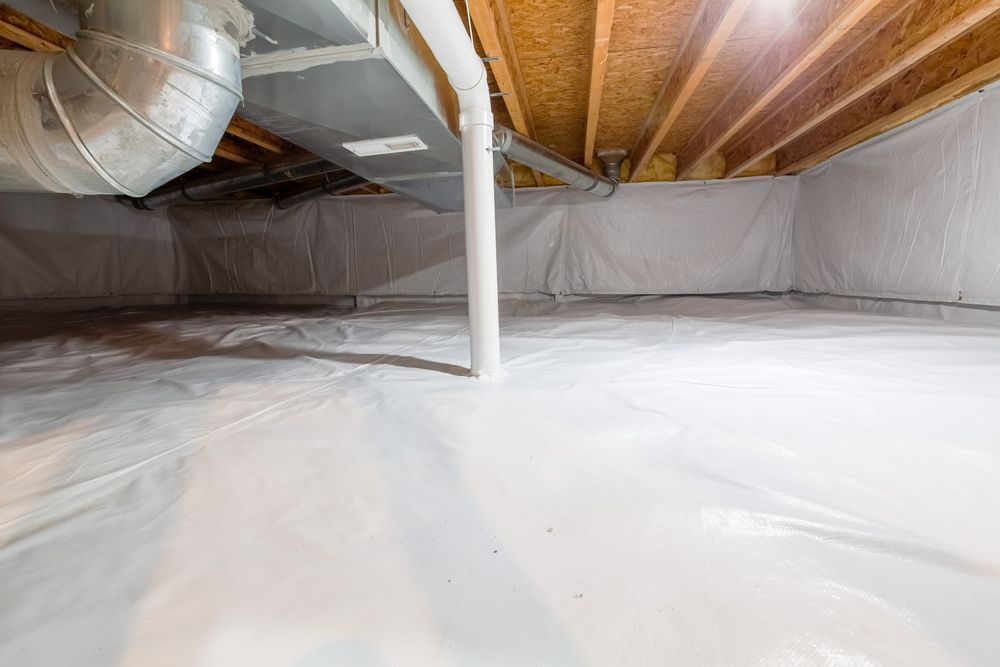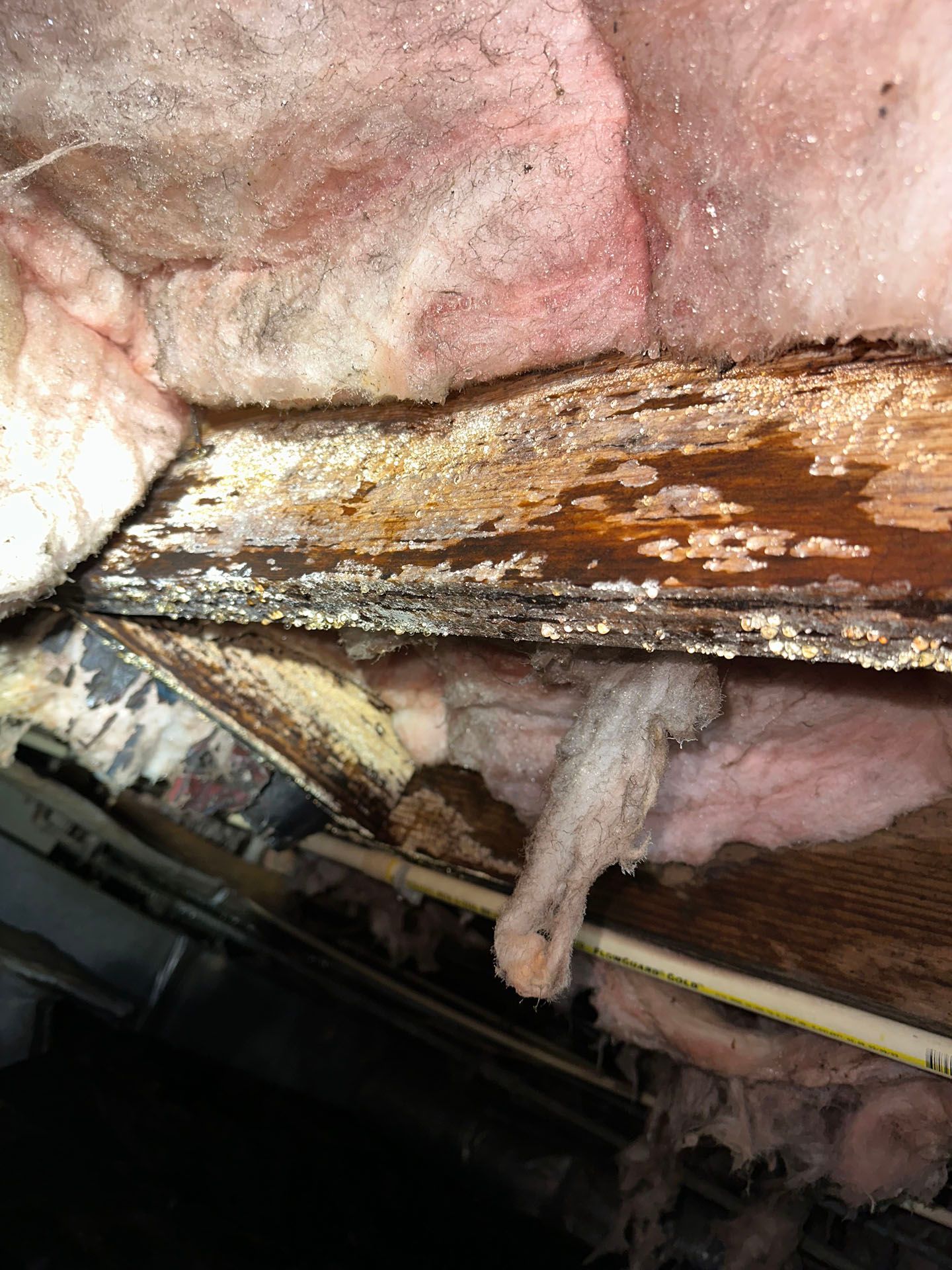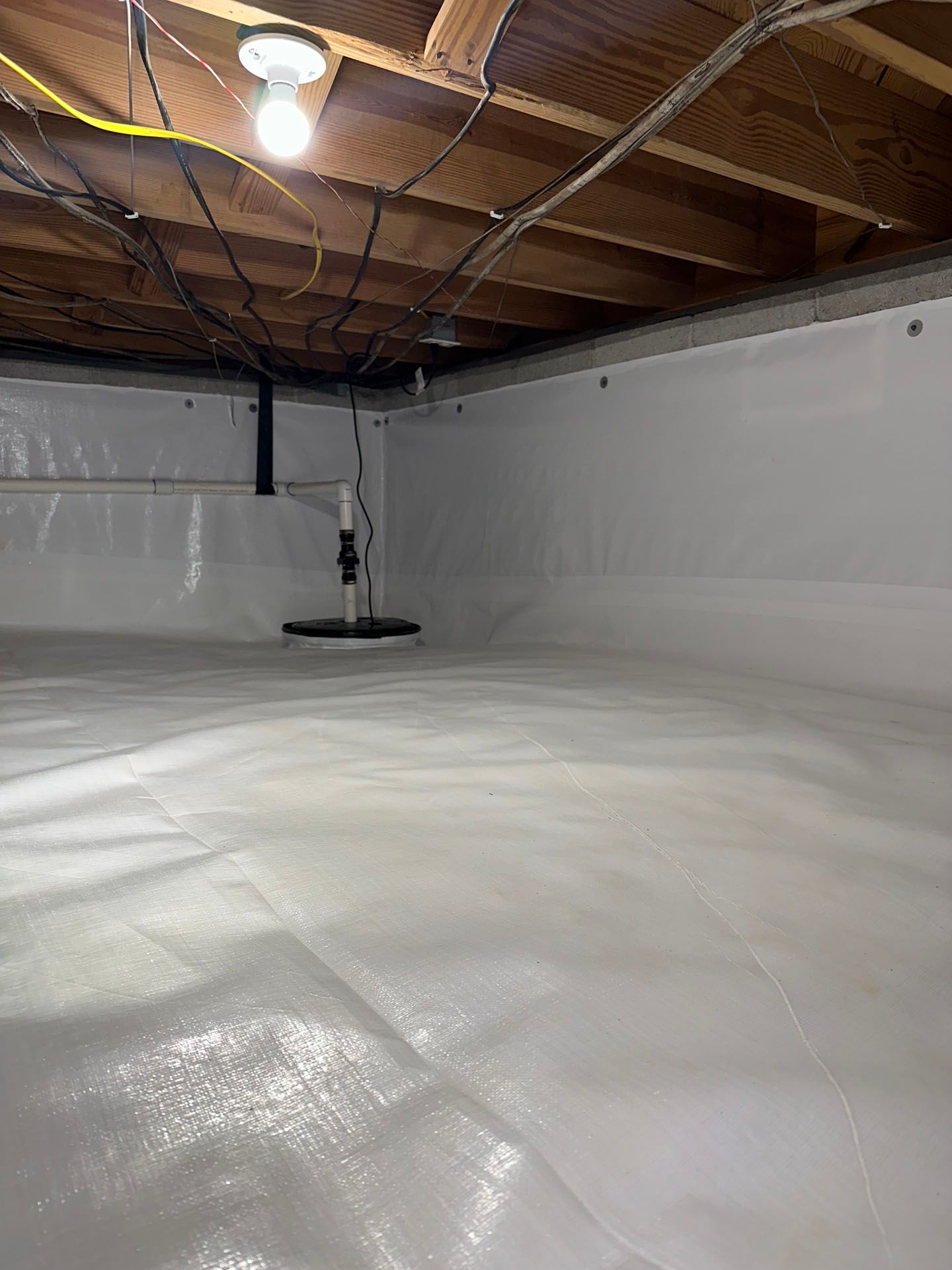Huntsville, Alabama

Claim Your FREE Crawl Space Inspection Today!
Sawyer Williams: 256-727-4422
Schedule Your Free estimate!
No-Obligation, Free Inspections
No-Obligation Free Estimates
We Warranty All of Our Work
100% Satisfaction Guaranteed
Termites aren't just a problem for houses with wooden siding or decks; they can also wreck havoc in the crawl space, which is often disregarded.
Don't ignore the potential risk of termites in your crawl space. Before it's too late and the stability of your home is in jeopardy, familiarize yourself with methods of detecting and fixing termite damage.
Overview of Crawl Space Termite Damage
Termite damage in a crawl area can be a serious issue for homeowners. Termites are tiny insects that devour wood, yet they may do a lot of harm to a house's framework.
Crawl spaces are a common point of entry because the pests are less likely to be spotted there. Crawl space termites can threaten a home's structural stability by eating away at wooden beams and supports. This can cause dangerous conditions and expensive repairs.
It's critical to be on the lookout for termite damage in the crawl area and to take care of it as soon as possible. The presence of termites can be indicated by the presence of several telltale signs:
- The presence of swarms of flying insects (termites or termite swarmers) in the basement, around windows, or in the doorframes.
- Wings thrown out of open windows or doorways
- The placement of mud tubes either outside the house or in the basement.
- Planks that have been weakened or are hollow
- Floors that are sagging or cracking.
Having a professional pest control company investigate your crawl area and evaluate the degree of the damage is essential if you suspect termite damage. They can give advice on what needs fixing or treatment to stop more infestations.
Signs of Crawl Space Termite Damage
There are a few telltale indicators that your crawl area is infested with termites. Keeping an eye out for these symptoms can help you take care of a potential problem before it escalates into a significant one.
Signs of termites include swarms of flying insects, which may appear around your home's foundation or entry points. Termite swarmers emerge in the spring and early summer because they are drawn to light.
Little wings discarded on doorframes and window sills may be a symptom of termites. After mating, termites discard their wings, therefore spotting wings is a good sign of a nearby colony.
Termites construct mud tubes to shield themselves from predators and the elements as they move about their environment. You can discover these piping systems either outside the house or in the basement or crawl area. Have a professional check for termite damage if you see mud tubes in your home.
If you tap on any wooden beams or supports in your crawl area and hear a hollow sound, this could be a symptom of termite damage. Termites chew their way through wood, leaving behind a weak and brittle exterior.
Floors that droop or split may be an indication that termites have destroyed the structural wood underpinning your home. This is a major problem that requires immediate attention.
A professional inspection and advice should be sought out if any of these indicators of termite damage in the crawl area are observed. Damage and expensive repairs may follow if the issue is ignored.
Causes of Crawl Space Termite Damage
Termite damage in a crawl space can be caused by a number of different things. Understanding these factors can help you take preventative measures in the case of an infestation.
Termites are attracted to wood and can enter a house through the crawl area if there is contact between the wood and the soil. If the crawl area includes untreated wood beams or supports touching the ground, this could happen.
High humidity in a crawl space might be inviting to termites since they thrive in wet conditions. Crawl spaces that aren't properly vented or have plumbing leaks might provide the ideal wet environment for termites to thrive.
Poor foundation repair Termites can get access to your home through cracks in the foundation. Termites can infiltrate the crawl area through cracks in the foundation or spaces around pipes and vents.
Termites love to nest in wood, so it's important to keep stacks of firewood and tree stumps away from your house. This wood waste serves as a pathway for these insects to enter the crawl area, where they can do extensive damage.
Termite damage can be avoided by keeping the crawl area dry and by maintaining the integrity of the home's foundation. Aside from keeping wood away from the house, it's also recommended that wood not come into contact with soil in the crawl area. It's best to have a professional pest control service look over your property and give you their advice if you suspect an infestation.
Prevention of Crawl Space Termite Damage
Crawl space termite damage can be avoided by the following measures:
Protect the foundation by filling up holes and closing cracks.
Maintaining a dry crawl space with good ventilation will help prevent termite infestations. Provide vents for air circulation in your crawl space.
Maintain a dry crawl area by addressing any plumbing leaks or other water infiltration issues. Termites can't survive in humid environments.
The contact between wood and soil should be eliminated wherever possible; for example, if you have untreated wood beams or supports in your crawl space, you should think about replacing them with treated wood. This will prevent the termites from easily gaining entry to the wood.
Eliminate any potential termite breeding grounds by removing any wood debris from the outside of your homes, such as piles of firewood or tree stumps. Reducing the likelihood of an infestation can be as simple as keeping wood waste at bay.
To stop termites from getting into your crawl space, use a chemical barrier around your home's foundation. Termites are unable to penetrate the chemical barrier created by this barrier.
Termite damage in a crawl area can be avoided with a few preventative measures. It's best to have a professional pest control service look over your property and give you their advice if you suspect an infestation. Damage and expensive repairs may follow if the issue is ignored.
Cost of Repairing Crawl Space Termite Damage
How much it will cost to fix termite damage in a crawl space will depend on how extensive the damage is and how big a space they have occupied. Repairing termite damage can be costly because it typically entails replacing or repairing damaged wood beams and supports in addition to any other affected materials.
The price for fixing the termite damage in your crawl space could vary depending on the following:
How extensive the damage is will determine how much it will cost to fix. Repair costs are likely to rise if termites have ravaged a sizable section of the crawl space, as opposed to a more contained area.
The extent of the damage is another factor that will affect how much it will cost to fix. The price tag will go up since expanding the crawl space will necessitate additional time and effort.
How much time and money will be required to fix it also depends on what needs fixing. A wooden beam, for instance, might be more expensive to replace than to fix.
Repair costs could differ based on where you live. Some parts of the country might have higher labor and material costs than others.
If you want an accurate estimate of how much it will cost to fix the termite damage in your crawl space, it is best to seek an estimate from a professional pest control firm or contractor. Obtaining various quotes allows you to assess costs.
When to Call a Professional for Crawl Space Termite Damage
As soon as you notice any signs of termite damage in your crawl space, get in touch with a specialist. A contractor or pest control service can evaluate the situation and make repair suggestions.
Some of the signs of termite damage in a crawl space that necessitate a repairman's requirements are as follows:
Damage to the crawl area should be repaired by a professional if termites have done significant damage to it. A contractor or pest control service can evaluate the situation and make repair suggestions.
The entire amount of damage caused by termites in a crawl area may be difficult to ascertain if the termites have gotten behind walls or under the flooring. A trained expert has the resources and knowledge to locate every damaged area.
If the termites have damaged the structure of the home's foundation or crawl area, this could pose a serious health and safety risk. A trained expert can examine the problem and decide whether or not urgent maintenance is required.
If you have never repaired termite damage before, it's probably best to hire a professional. Complex repairs often necessitate expert knowledge and unique equipment. A trained specialist will know exactly what to do to get the job done right and safely.
Simply put, if you find termite damage in your crawl space, you should get an expert's opinion on the situation and advice on how to fix it. Ignoring the issue may lead to more extensive damage and more expensive remedies.
DIY Repair of Crawl Space Termite Damage
Repairing termite damage in your crawl space is best left to the pros, but you might be able to handle some basic fixes on your own. Remember, though, that fixing termite damage can be difficult and might call very specialist knowledge and equipment. You should consult a professional if you have any doubts about your capacity to make the repairs safely and properly.
DIY advice for fixing termite damage in crawl space:
It's crucial to take stock of the damage before diving into restoration work. Look for termite damage indicators like mud tunnels, abandoned wings, and hollowed-out wood. Getting a professional's opinion is recommended if the harm is significant or if you are unsure of its scope.
If you have located a little section of damaged wood, you may be able to take care of it on your own by cutting it out. Remove the damaged wood with a saw or chisel, taking care not to harm the surrounding wood.
After the damaged wood has been removed, it can be repaired or replaced. Wood filler could be used to fix the wood if the damage isn't too severe. All or part of the wood may need to be replaced if the damage is severe.
It is vital to treat the area after repairing or replacing damaged wood in order to discourage further infestations. The wood might be treated with an insecticide or preservative.
If you want to fix termite damage in your crawl space yourself, exercise extreme caution. A professional should be called in if you have any doubts about your capacity to make the repairs in a safe and effective manner. It could get worse and cost more to fix if you ignore the issue or try to fix it yourself if you don't have the necessary skills.
Insurance Coverage for Crawl Space Termite Damage
The specifics of your insurance coverage will determine whether or not they will pay for repairs due to termite infestation in your crawl area. Damage caused by termites is typically not covered by homeowner's insurance plans because insurers view termites as a solvable, rather than inevitable, problem. However, termite damage coverage may be available as an endorsement or rider on some policies.
Crawl space termite damage may be covered by your homeowner's insurance, but you'll need to check your policy to be sure. It's a good idea to add an endorsement or rider to your policy if you don't already have protection against this sort of loss.
It is crucial to know the limits and specifics of your policy if it covers damage caused by termites in your crawl area.
Coverage for termite damage may be limited in some policies, and some forms of damage may be specifically excluded. It's possible, for instance, that the insurance won't pay for the full price of replacing the rotten wood, merely the price of removing the pests.
Contact your insurance carrier immediately if you find evidence of termite damage in your crawl space. They will explain your policy and give you advice on filing a claim. It is also recommended that you take photos of the damage and save receipts for any treatments or repairs you may have paid for. This can increase your chances of receiving the maximum compensation for which you are eligible.
Health Risks of Crawl Space Termite Damage
Although termites do not pose an immediate threat to human health, the structural damage they do in crawl spaces can lead to secondary health issues. The following are some of the health concerns that may arise from termite damage in crawl space:
Structural damage: If termites have wreaked havoc on the crawl area, this could jeopardize the stability of the house's foundation. As a result, there is a risk of structural damage, such as sinking floors or walls.
Fine dust created by termites eating wood may carry allergies. Inhaling this dust can trigger allergic reactions in those who are vulnerable.
Mildew: If termites have damaged the crawl space's moisture barrier, mold development is a distinct possibility. Mold is dangerous because it can trigger asthma attacks, allergic reactions, and other health concerns.
Without proper ventilation, carbon monoxide can build up in a crawl space that also houses a gas furnace or water heater. Carbon monoxide is a lethal gas that has no taste or smell but can cause instant death if ingested.
Repairing termite damage in a crawl space as soon as possible will lessen the danger to human health. It is best to have a professional pest control service or contractor examine the damage and make repair suggestions. Also, getting frequent inspections of your crawl area might help you spot problems early on.
Long-Term Effects of Crawl Space Termite Damage
Long-term repercussions on the stability of the home's foundation and the property's value might result from neglected termite damage in the crawl space. The termite damage in your crawl area could cause the following long-term problems:
Structural damage: If termites have wreaked havoc on the crawl area, this could jeopardize the stability of the house's foundation. As a result, there is a risk of structural damage, such as sinking floors or walls.
Property value reduction: termites can do serious damage to a house's framework, reducing its market value. If you ever decide to put your house up for sale, termite damage may be a deal breaker for potential buyers.
Increased repair costs are possible if the damage caused by termites in a crawl space is ignored. The longer damage is ignored, the more it could cost to fix.
Fixing problems in your crawl area as soon as possible might help you prevent costly repairs later on due to termite infestation.
It is best to have a professional pest control service or contractor examine the damage and make repair suggestions. Also, getting frequent inspections of your crawl area might help you spot problems early on.
Frequently Asked Quetions
-
What are the most typical indications of termite damage in a crawl space?
Swarms of winged insects (termite swarmers), abandoned wings near windowsills or doors, mud tubes on the exterior of the property or in the crawl space, hollow or damaged wood, and sagging or cracked floors are all classic symptoms of termite damage in a crawl space.
-
Is it possible to fix the damage that termites caused in the crawl space?
Termite damage in a crawl area may typically be fixed. However, the cost and difficulty of the repair will depend on the level of damage and the nature of the repair required. There are times when wooden beams or pillars need to be replaced because of damage. A specialist should inspect the damage and provide a solution for fixing it.
-
What measures may be taken to keep termites out of a crawl space?
Crawl space termite damage can be avoided through regular foundation maintenance, proper ventilation, a lack of moisture, the elimination of wood-to-soil contact, the removal of outdoor wood debris, and the installation of a chemical barrier along the perimeter of the crawl space. Also, getting frequent inspections of your crawl area might help you spot problems early on.

Written by Sawyer Williams
Precision Crawlspace & Renovations
Sawyer has specialized in crawl space and foundation repairs for over six years. As the founder of Precision Crawlspace and Renovations, he is one of Huntsville's top experts in crawlspace moisture control. He has prior experience installing these systems, which has prepared him to solve complex problems related to crawl space encapsulation, mold remediation, and waterproofing.
Recent Blog Posts
Huntsville's Crawl Space News



What are you waiting for?
We Solve Crawl Space Issues!
Get reliable crawl space repair services at an affordable price, provided with the high level of service you deserve.
Call Us Today at: 256-727-4422
All Rights Reserved | Precision Crawlspace & Renovations

